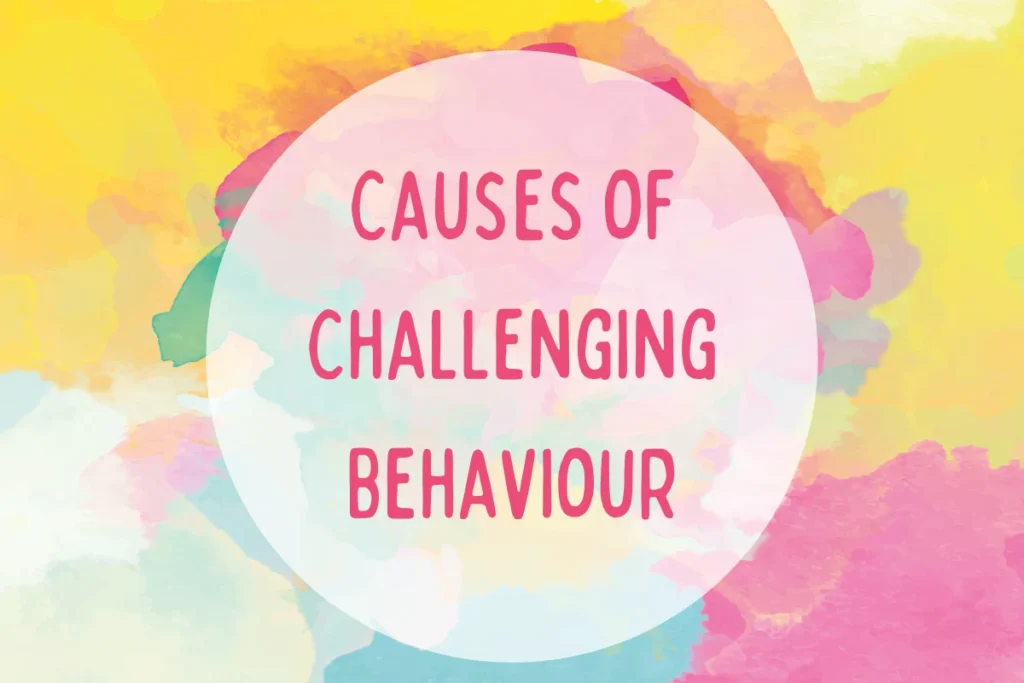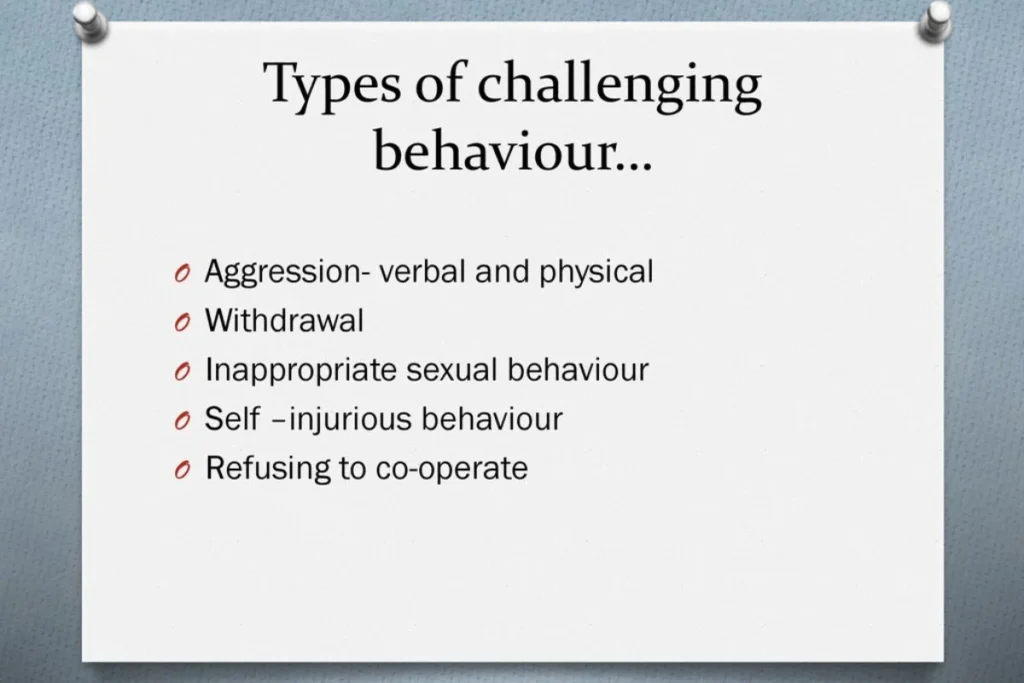Challenging behaviour includes actions like hitting, hurting oneself, or refusing to listen to instructions. This can make providing care harder, but they usually have underlying reasons behind them.
This guide will explain the types of challenging behaviour, why these things occur, and helpful strategies to help with kindness in care.
Table of Contents
What is Challenging Behaviour?
Challenging behaviour refers to actions that disrupt daily activities, pose risks to others, or require extra support to manage. These behaviours, such as aggression, self-injury, or withdrawal, often act as a form of communication, especially for individuals who struggle to express their needs or emotions verbally.
Understanding challenging behaviour is vital in caregiving as it helps identify triggers, address underlying issues, and provide better support. Key points to consider include:
- Aggression: This may indicate frustration, physical pain, or sensory overload.
- Self-Injury: Often linked to emotional distress, sensory needs, or an attempt to relieve pain.
- Withdrawal: Can reflect sadness, anxiety, or feelings of isolation.
By recognising these behaviours as attempts to communicate, caregivers can respond empathetically and develop practical strategies to meet the individual’s needs and improve their overall well-being.
Description of Challenging Behaviour
| Behaviour | Impact | Reason |
| Aggression | Can cause physical harm to self or others | It could happen when someone feels threatened or unheard. |
| Self-Harm | Can cause injury, pain, and distress. | It could be a response to overwhelming emotions or sensory overload. |
| Non-Compliance | Prevents learning and daily activities. | May occur when someone doesn’t understand instructions or feels anxious. |
| Verbal Outbursts | Can be distressing to self and others | Sometimes a way to show strong emotions or frustration. |
| Withdrawal | This can lead to social isolation | This might happen when someone feels overwhelmed or scared. |
Managing challenging behaviour takes patience and understanding. For those who need extra support, options like supported living for adults provide a safe and comfortable place to help them feel at ease.
Causes of Challenging Behaviour

Challenging behaviour often stems from underlying factors that impact an individual’s ability to cope or communicate effectively. Recognising the causes of challenging behaviour is essential to providing the right support. Below are common triggers of challenging behaviour and their potential impact:
Unmet Needs
- Physical discomfort such as pain, hunger, or illness can lead to frustration and aggression.
- Emotional needs like loneliness, fear, or a lack of connection may result in withdrawal or disruptive actions.
Communication Barriers
- Difficulty expressing thoughts or emotions can cause behaviours that challenge, especially for individuals with speech or language limitations.
- Misunderstandings due to unclear instructions often lead to frustration or non-compliance.
Environmental Factors
- Overstimulating environments, such as loud noises, bright lights, or crowded spaces, are common triggers of challenging behaviour.
- Sudden changes in routine or unfamiliar settings can increase anxiety, resulting in disruptive actions.
Mental Health Issues
- Conditions like anxiety, depression, or trauma-related stress can manifest as challenging behaviours.
- Disorders such as autism or ADHD often contribute to behaviours that require additional support.
Social Factors
- Limited social skills or a lack of supportive relationships may lead to feelings of frustration, causing outbursts.
- Feeling ignored or undervalued can also trigger challenging actions.
By understanding the reasons for challenging behaviour, caregivers can identify triggers and offer compassionate, practical support. Recognising behaviour as a form of communication allows for meaningful responses that help individuals feel safe and understood.
Sources for Further Reading:
- Challenging Behaviour: Understanding Causes and Triggers – Nurseline
- Causes of Challenging Behaviour in Care – CareLearning
Types of Challenging Behaviour

Challenging behaviour can be divided into distinct categories, each with its own characteristics and causes. Below is a summary of the most common types of challenging behaviour:
- Physical Aggression: Actions that cause harm to others or damage property, such as hitting or throwing objects.
- Verbal Aggression: Use of words to express frustration or anger, including shouting or swearing.
- Self-Harm Behaviour: Intentional actions to hurt oneself, often as a response to emotional distress or sensory needs.
- Disruptive Behaviour: Behaviours that interfere with routines, such as refusing instructions or causing interruptions.
Here are some detailed examples of challenging behaviour:
| Type | Examples of Challenging Behaviour | Causes |
| Physical Aggression | Hitting, biting, throwing objects | Frustration, sensory sensitivities, or overload |
| Verbal Aggression | Shouting, swearing, threatening language | Stress, emotional overwhelm, communication barriers |
| Self-Harm Behaviour | Head-banging, hand-biting, skin-picking | Emotional distress, sensory-seeking behaviours |
| Disruptive Behaviour | Refusal to follow instructions, outbursts, interrupting activities | Anxiety, changes in routine, unfamiliar settings |
Real-Life Examples of Challenging Behaviour
Challenging behaviours can appear in various settings and impact individuals of all ages. Below are real-life examples of challenging behaviour to provide a clearer understanding of how they manifest in different contexts.
Challenging Behaviour Examples in Children
Children often display challenging behaviours as a way to communicate unmet needs or cope with overwhelming situations.
- Refusing to follow instructions during class, leading to disruptions.
- Throwing tantrums in response to sensory overload, such as loud noises or bright lights.
- Hitting or pushing peers when feeling frustrated or misunderstood.
- Avoiding eye contact or withdrawing from group activities due to anxiety.
Challenging Behaviour Examples in Care Homes
In adults, challenging behaviours often arise in care settings where individuals may struggle with communication, routine changes, or emotional distress.
- Displaying aggression toward caregivers, such as shouting or physical outbursts, during personal care tasks.
- Withdrawing socially, avoiding conversations or group activities when feeling overwhelmed.
- Engaging in self-harming behaviours, like skin-picking or hand-biting, as a response to stress.
- Refusing medication or care, resulting in disruptions to daily routines.
Early recognition can prevent behaviours from escalating. Supportive environments, such as adult daycare facilities, provide structured care and reduce stress.
Early Signs and Identification of Challenging Behaviour
How to Identify Early Signs of Challenging Behaviour
Recognising early signs of challenging behaviour is key to preventing escalation and providing timely support. Observing patterns and triggers helps caregivers understand needs and respond proactively, creating a calmer environment.
Key Early Signs
- Increased irritability or frequent frustration.
- Avoidance of eye contact or withdrawal from social interaction.
- Repeated actions like pacing, fidgeting, or tapping.
- Verbal clues such as a louder tone, hesitant speech, or changes in communication.
- Resistance to changes in routine or environment.
A detailed guide on Strategies for dealing with challenging behaviour can provide actionable tips and insights to support individuals effectively. Below are simple, practical ways to manage challenging behaviours effectively.
Strategies for Managing Challenging Behaviour
When dealing with challenging behaviour, it’s important to take a proactive and understanding approach. A widely recognised framework for this is Positive Behaviour Support (PBS), which focuses on understanding the reasons behind behaviours and addressing them effectively.
Positive Behaviour Support (PBS)
Positive Behaviour Support (PBS) is a person-centred approach that helps manage challenging behaviours by focusing on their root causes. It aims to improve the quality of life for individuals while creating a supportive environment.
Key Principles of PBS:
- Identify Triggers: Recognise what causes behaviours, like sensory overload or frustration.
- Focus on Positive Alternatives: Teach new skills or responses to replace challenging actions.
- Create Supportive Environments: Make changes to surroundings that reduce stress.
- Involve the Individual: Encourage active participation in decisions about their care.
PBS principles align well with services like Challenging Behaviour Care, which focuses on creating supportive environments and reducing behavioural triggers.
Actionable Tips for Managing Challenging Behaviour
- Recognise Triggers: Notice what causes the behaviour. It might be loud noises, frustration, or a need that hasn’t been met.
- Keep Communication Simple: Use clear and easy-to-understand words. Visual aids can also help.
- Stick to Routines: Having a predictable daily schedule can make people feel safer and less anxious.
- Reward Good Behaviour: Praise or small rewards can encourage positive actions.
- Create a Calm Space: Reduce distractions like bright lights or loud sounds to help with focus and relaxation.
- Teach Coping Techniques: Show calming methods like deep breathing or using stress-relief items.
- Ask for Expert Help: If needed, contact a therapist or specialist for extra guidance.
Matching Strategies to Behaviour
Here’s a quick guide to managing different types of behaviours:
| Type of Behaviour | How to Manage It |
| Physical Aggression | Stay calm, give space, and redirect their energy to something safe, like an activity. |
| Verbal Aggression | Avoid arguing, listen calmly, and show that you understand their feelings. |
| Self-Harm Behaviour | Provide comforting tools, stay close for support, and reassure them with kind words. |
| Disruptive Behaviour | Set clear rules, give choices to feel in control, and use rewards for good actions. |
Conclusion
Managing challenging behaviour requires patience, understanding, and the right strategies. By recognising the types of challenging behaviour, identifying triggers, and offering support, you can create a positive environment where individuals feel safe and understood.
Remember, every action is a form of communication, and addressing the root causes makes a big difference. If you’re looking for professional care and support, Metro Care UK is here to help.
Our experienced team specialises in handling challenging behaviour with compassion and expertise. Contact us today to learn how we can assist you or your loved ones in a supportive and caring environment.
Frequently Asked Questions About Challenging Behaviour
What are the four types of challenging behaviour?
The four types are physical aggression (e.g., hitting), verbal aggression (e.g., shouting), self-harm (e.g., head-banging), and disruptive behaviour (e.g., refusing instructions). These behaviours often arise from unmet needs, communication difficulties, or stress.
What are challenging behaviours in care homes?
Challenging behaviours in care homes include aggression toward staff, verbal outbursts, refusing care, or social withdrawal. These behaviours often stem from frustration, emotional distress, or difficulties adjusting to the care environment.
How are challenging behaviours categorized?
Challenging behaviours are categorized as aggressive (toward others), self-injurious (causing self-harm), disruptive (interfering with routines), or withdrawn (avoiding social interactions). Each category reflects a different response to underlying triggers like stress or unmet needs.
What is Positive Behaviour Support (PBS)?
PBS is a person-centred approach that focuses on understanding the causes of challenging behaviour. It aims to reduce triggers, teach positive alternatives, and create supportive environments. PBS is widely used to improve quality of life and manage behaviours effectively.
What causes challenging behaviour?
Challenging behaviour can be caused by unmet needs, communication barriers, sensory overload, mental health conditions, or environmental factors. Recognising these causes helps caregivers respond with empathy and address the root issues effectively.

